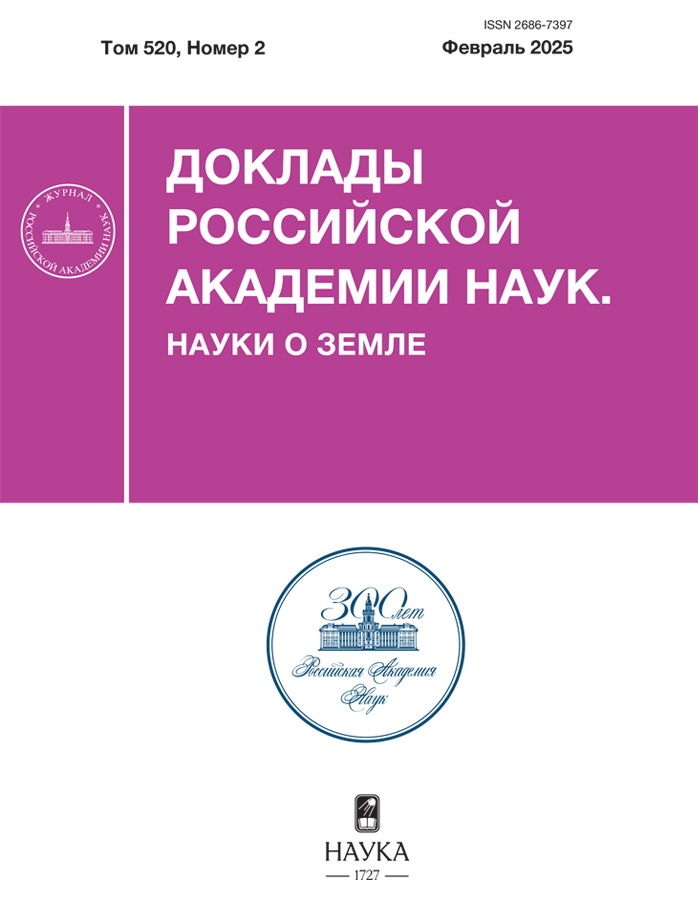Estimates of possible changes of open water period in Russian exclusive economic zone in the Arctic in the 21 century
- Autores: Semenov V.A.1,2, Cherenkova E.A.1,2
-
Afiliações:
- A.M. Obukhov Institute of Atmospheric Physics, Russian Academy of Sciences
- Institute of Geography of the Russian Academy of Sciences
- Edição: Volume 520, Nº 2 (2025)
- Páginas: 325-332
- Seção: CLIMATIC PROCESSES
- ##submission.dateSubmitted##: 19.06.2025
- ##submission.dateAccepted##: 19.06.2025
- ##submission.datePublished##: 04.09.2025
- URL: https://transsyst.ru/2686-7397/article/view/685369
- DOI: https://doi.org/10.31857/S2686739725020173
- EDN: https://elibrary.ru/GCPFWV
- ID: 685369
Citar
Texto integral
Resumo
The rapid reduction of the Arctic Sea ice area in recent decades and the increase in the duration of ice-free navigation along the Northern Sea Route is one of the positive consequences of the global warming for Russia. At the same time, further retreat of the sea ice may lead to a prolonged seasonal open water period outside the Russian exclusive economic zone (REEZ) with significant economic and geopolitical risks. The paper provides estimates of possible changes of the sea ice concentration in the Arctic and the duration of open water period, including outside of REEZ in the 21st century, based on the CMIP6 climate model ensemble for moderate and aggressive scenarios of anthropogenic forcing. In particular, it is shown that already by the middle of the 21st century, the duration of ice-free navigation outside REEZ may exceed two and a half months.
Texto integral
Sobre autores
V. Semenov
A.M. Obukhov Institute of Atmospheric Physics, Russian Academy of Sciences; Institute of Geography of the Russian Academy of Sciences
Autor responsável pela correspondência
Email: cherenkova@igras.ru
Academician of the RAS
Rússia, Moscow; MoscowE. Cherenkova
A.M. Obukhov Institute of Atmospheric Physics, Russian Academy of Sciences; Institute of Geography of the Russian Academy of Sciences
Email: cherenkova@igras.ru
Rússia, Moscow; Moscow
Bibliografia
- Володин Д.А. Россия, Канада и новые морские пути в Арктике // США ‒ Канада. Экономика, политика, культура. 2013. № 3. C. 53‒70.
- Мохов И.И., Погарский Ф.А. Изменения режимов морского волнения в Арктическом бассейне при изменениях климата в XXI веке по модельным расчетам // Доклады РАН. Науки о Земле. 2021. Т. 496. № 2. С. 189‒193. https://doi.org/10.31857/S2686739721020134
- Мысленков С.А. Анализ высоты ветровых волн и продолжительности безледного периода вдоль Северного морского пути с 1979 по 2021 гг. // Вестник Московского университета. Серия 5. География. 2024. № 2. С. 134‒145. https://doi.org/10.55959/MSU0579-9414.5.79.2.11
- Парфенова М.Р., Елисеев А.В., Мохов И.И. Изменения периода навигации в Арктических морях на Северном морском пути в 21 веке: байесовы оценки по расчетам с ансамблем климатических моделей // Доклады Российской академии наук. Науки о Земле. 2022. Т. 507. № 1. С. 118‒125. https://doi.org/10.31857/S2686739722601454
- Проскуряков М.Р. Геополитика Арктики – новый формат для диалога // Universum: общественные науки: электрон. научн. журн. 2022. 11(90). URL: https://7universum.com/ru/social/archive/item/14550 (дата обращения: 05.01.2024).
- Семенов В.А., Мартин Т., Беренс Л.К., Латиф М., Астафьева Е.С. Изменения площади арктических морских льдов в ансамблях климатических моделей CMIP3 и CMIP5 // Лёд и Снег. 2017. Т. 57(1). С. 77–107. https://doi.org/10.15356/2076-6734-2017-1-77-107
- Семенов В.А., Черенкова Е.А., Алдонина Т.А. Современные и ожидаемые характеристики сезонного хода ледового покрова в морях Российской Арктики // Доклады Российской академии наук. Науки о Земле. 2023. Т. 511. № 1. С. 112–118. https://doi.org/10.1134/S1028334X23600780
- Boylan B.M. Increased maritime traffic in the Arctic: Implications for governance of Arctic Sea routes // Marine Policy. 2021. V. 131. P. 104566. https://doi.org/10.1016/j.marpol.2021.104566
- Jahn A., Holland M.M., Kay J.E. Projections of an ice-free Arctic Ocean // Nat Rev Earth Environ. 2024. V. 5.P. 164–176. https://doi.org/10.1038/s43017-023-00515-9
- Liu M., Kronbak J. The potential economic viability of using the Northern Sea Route (NSR) as an alternative route between Asia and Europe // J. Transp. Geogr. 2010. V. 18(3). P. 434–444. http://dx.doi.org/10.1016/j.jtrangeo.2009.08.004
- Matveeva T.A., Semenov V.A. Regional Features of the Arctic Sea Ice Area Changes in 2000–2019 versus 1979–1999 Periods // Atmosphere. 2022. V. 13. P. 1434. https://doi.org/10.3390/atmos13091434
- Meier W.N., Stroeve J. An updated assessment of the changing Arctic sea ice cover // Oceanography. 2022. V. 35. P. 1–10.
- O’Neil et al. The Scenario Model Intercomparison Project (ScenarioMIP) for CMIP6 // Geosci. Model Dev. 2016. V. 9. P. 3461–3482.
- Schøyen H., Bråthen S. The Northern Sea route versus the Suez Canal: cases from bulk shipping // J. Transp. Geogr. 2011. V. 19(4). P. 977–983. http://dx.doi.org/10.1016/j.jtrangeo.2011.03.003
- Theocharis D., Pettit S., Rodrigues V.S., Haider J. Arctic shipping: A systematic literature review of comparative studies // Journal of Transport Geography. 2018. V. 69. P. 112‒128.
- The United Nations Convention on the Law of the Sea, Treaty series, 1982. V. 1834. №1-31363. 370 p. URL: https://www.un.org/ru/documents/decl_conv/conventions/pdf/lawsea46-84.pdf (дата обращения: 04.01.2024).
- Tudorache V.P., Antonescu N.N. Challenges of oil and gas exploration in the Arctic // Journal of Engineering Sciences and Innovation. 2020. V. 5. Issue 3. P. 273‒286.
Arquivos suplementares














